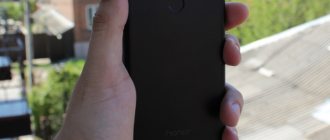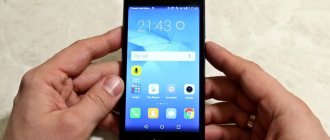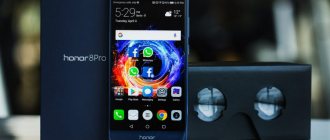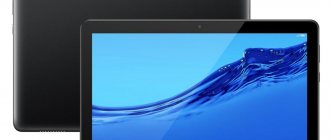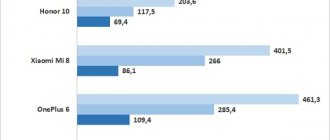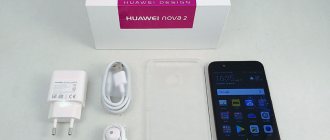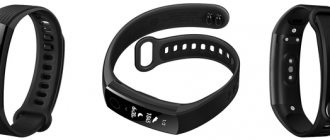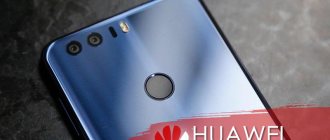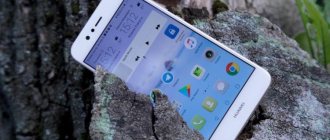The Huawei P Smart Plus smartphone features a modern, powerful Kirin 710 processor, a 6.3" diagonal, four cameras and a low price. In China it is called Huawei Nova 3I, in Europe P Smart Plus. As the name suggests, it is an improved version of the Huawei P Smart smartphone. The smartphone has a powerful processor, and the resolution of the main camera has increased slightly. The device has become larger and less compact. The phablet belongs to the middle price range. Its cost is about 15 thousand rubles.
Design
The Huawei P Smart Plus phone is made of glass, polycarbonate and aluminum. The view is as beautiful as most phablets. Cover available in black, white or Iris Purple.
On the rear panel there is a camera block located vertically, under which there is an LED flash. Below, in the center, there is a fingerprint scanner, slightly recessed into the body. The brand logo is printed vertically at the bottom.
The front surface consists almost entirely of the display. It occupies 82% of the area. The frames are very thin. The top frame is extended with a monobrow, which houses all the standard sensors, a selfie camera and an earpiece.
On the right side there are power and volume buttons, on the left there is a card slot. At the bottom there is a USB Type-C connector.
Dimensions: 15.8 x 7.5 cm, thickness 7.6 mm. Weight 169 g.
Display
In mid-class phones, all manufacturers except Samsung use IPS matrices. Only in flagships you will find OLED screens. Since P Smart belongs to the middle class, it also has an IPS display, but of high quality. It is good in all respects: high brightness, minimal color distortion when viewed at an angle, picture saturation. In the dark, users will be able to set the minimum brightness at which it is comfortable to read, but the automatic adjustment mode does an excellent job of this.
In the screen parameters, you can change the mode from normal to “Bright”, plus you can set the color temperature and generally adapt the screen to suit you. There is a function to change the display resolution from Full HD+ to regular HD+. The quality of the picture drops noticeably, the so-called “grain” appears on the screen, but with HD+ resolution, energy consumption decreases and battery life increases. If you see that there is 20-30% battery charge left, and there is no charger nearby, then it is better to turn on HD+ mode.
Technical parameters and performance
Technical characteristics of Huawei P Smart Plus are located in the table:
| Chipset | Kirin 710 |
| Number of Cores | 8 |
| CRU architecture | 4 Cortex-A73 x 2.2 GHz + 4 Cortex-A53 x 1.7 GHz |
| Video processor | Mali-G51 MP4 |
| Random access memory | 4 GB |
| Built-in memory | 64 GB |
| operating system | Android 8.1 (Oreo) |
| Shell | EMUI 8.2 |
The amount of memory is sufficient at the present stage for most users. It is possible to install an additional memory card up to 256 GB by installing it in the second slot instead of a SIM card. The chipset is quite powerful and productive (12 nm process technology), it easily copes with most everyday tasks. The smartphone is positioned by the manufacturer as a device for light and medium games. They move without sagging or braking.
The presence effect is facilitated by the use of separate ISP and DSP video and digital signal processors. GPU Turbo technology helps achieve smooth gameplay and ensures stable frame rates. Quick transition between 4G and Wi-Fi allows you to not notice any connection interruptions. During the game, the main array of messages is not shown.
The Huawei P Smart Plus smartphone will help you find the item you need in the Amazon APP with a long double press. Artificial intelligence helps you sort through your photos, organizing them by date, location, or characters depicted in them.
Review of Huawei P Smart+: the most successful youth smartphone of 2021
The Huawei P Smart smartphone, along with the P8 lite 2021 model, became one of the company’s most successful devices on the Ukrainian market last year, which collectively contributed to strengthening the manufacturer’s position in Ukraine. With a price of 8,000 hryvnia, it had an excellent appearance and good sales. The new Huawei P Smart+ has every chance of surpassing the success of its predecessor, and several things speak in favor of this. This smartphone looks more expensive than it costs (its price is almost lower than in China; I wouldn’t be surprised if Huawei, in pursuit of market share, subsidizes this model on the Ukrainian market, trying to pull the rug out from under its main competitor, Samsung): two-thirds of sales come from the signature gradient color Iris Purple, which it inherited from the flagship model Huawei P20 (where it was called Twilight) - it looks excellent, despite the easily soiled glass surface. It has a large 6.3-inch screen with a resolution of 2340x1080 pixels and “elongated” proportions: an aspect ratio of 19.5:9. Buyers today like large screens that allow them to stop using tablets (with such a screen, for most ordinary buyers, a smartphone replaces a computer, at least for everyday tasks). Finally, it has two dual cameras - an idea that is not so much technical and innovative as marketing. In the era of the end of the gigahertz and megapixel race, it is the number of cameras that has become a simple and measurable factor for buyers who need some kind of measurement when comparing phones. Finally, the 24-megapixel selfie camera is capable of attracting the attention of the youth audience - the one for whom it is, in fact, designed. Add to this a design borrowed from the iPhone X (vertical orientation of the dual camera on the rear panel and a notch on the screen that irritates geeks so much).
Appearance
The design of Huawei P Smart+ was created according to the textbook: a relatively frameless screen (the frame is really thin, but this is a given, not a record), a large diagonal (and, I repeat, because of the “elongated” proportions it is comfortable to hold in the hand) and a cutout on the screen, so annoying to geeks, and which is known to be easy to disable in the screen settings. Noteworthy are the two front cameras, which we will return to later.
The back surface has a beautiful gradient that gives the smartphone an “expensive” look. Citrus claimed that 70% of P Smart+ sales were from this color variant - it is actually popular. In addition, it fulfills the legendary “three meters” rule, adopted for many years as a Motorola design rule: the phone model must be guessed from a distance of three meters. It has a glass surface that is quite easily soiled, but over a month of use it has not received any damage, although the phone has been dropped several times. At the same time, I landed on the corners and they received a couple of small damages in the form of a polishing that was cut off by a couple of millimeters.
The fingerprint sensor, according to Huawei's already established tradition, is located on the rear panel.
Everything is normal at the ends of the smartphone: the power button and the rocker that controls the sound volume are located on the right. A hybrid tray for two SIM cards with microSD support is located on the left. At the bottom there is a speaker, a headphone output and a microUSB connector, which causes an inevitable sigh from USB-C lovers like me.
Camera modules close-up. The main camera with two lenses protrudes from the rather thin body. The desire to make the phone thinner probably deserves attention and attracts buyers who do not think that an extra couple of millimeters in the thickness of the case could make it possible to place a battery with a higher capacity. On the other hand, if the spectacular appearance of a smartphone is its main trump card, “outperforming” the technical characteristics, is it worth blaming the developers for doing something “wrong”? After all, their goal was precisely to reduce the thickness.
How good is the Huawei P Smart+ screen?
What can Huawei P Smart+ screen measurement results tell us? The color gamut sags slightly in the green and red spectrum. This is also evidenced by the color temperature - there is more cold and blue in the screen than we would like. We see the same diagnosis in the RGB spectrum: blue predominates over red, the screen has “cooler” colors. The gamma curve of the screen shows that the most deviations from the norm are in light colors. Those who want to better understand these graphs should read our special article on how we measure screen quality and what all these graphs mean. In fact, all you need to know about the screen of this smartphone is that it is far from ideal, but for its price segment this is not as critical as it might seem. Because we place high demands on the flagship and most expensive smartphones, that is, all these listed deviations are within the acceptable limits and within the framework of the existing world, which is far from ideal.
What kind of performance can you expect from Huawei P Smart+
The smartphone uses the new Huawei Kirin 710 processor, which, judging by the index, should compete with the Qualcomm Snapdragon 710 processor. It is clear that we are most interested in performance records in flagship processors, and this is not the case. But still, a (potential) buyer of Huawei P Smart+ would be interested to know what kind of performance they can expect. And the answer, as expected in such cases, is that it cannot be answered unambiguously. In AnTuTu, the smartphone scored 131,431 points, which, by today's standards, is a fairly average result. Its performance is more on par with the Galaxy S6 or the first Pixel. On the other hand, this processor, like the flagship Kirin 970, uses a new neural network support module (NPU), and Android 8 already has corresponding support for neural networks. Therefore, in tasks with computer vision (in practice, this is still used in the camera for scene recognition and automatic selection of the optimal exposure and post-processing of the image), it can demonstrate good results: in the PC Mark Computer Vision benchmark it scored 5196 points, which is even more than the Mate 10 showed with a more powerful processor. For comparison, the more expensive Asus Zenfone 5 with the new progressive Snapdragon 636 processor, which also supports neural networks, scored 3238 points in the same test. In practice, 4 gigabytes of RAM also contribute to the comfort of work, and my smartphone slowed down in games and “heavy” applications like Facebook, which devours all the resources, if a dozen applications were running (this happens to me almost always). And in games this did not happen in all games (although even in Boom Beach, which was not the most graphics-heavy game, the processor could choke when landing an assault force of a couple of hundred units). So, at peak loads, the processor may not cope with tasks perfectly, but in ordinary life this is annoying only when photographing children or animals, when a delay of even half a second from the moment you press the shutter button to the result can play a role. I repeat - if you use your smartphone in “single-tasking” mode, this does not happen.
How artificial intelligence works in the Huawei P Smart+ camera
Shooting with a camera, on the contrary, is the most popular function in a smartphone, so when working with it (or rather, with both, because the front camera of this model is an important factor when purchasing - dual modules, HDR support and f/2.0 aperture make their marketing and technical matter). Firstly, this smartphone's camera, as already mentioned, was trained on millions of photos (you don't think Google just gives you free storage for your photos in Google Photos? If you don't pay anything, then you are the product, that is, neural networks were trained on your photographs, among other things) and can recognize a scene without an Internet connection. It works very simply - we turn on the AI shooting mode (unfortunately, only one resolution is available in it - 4608x3456 with a 4:3 frame aspect ratio, while I have long been accustomed to 16:9), then point the camera at the object and see the following results:
Sometimes neural networks make mistakes (although, of course, one can assume that there are smart cats deliberately trying to deceive artificial intelligence), and then you can see funny results:
And sometimes the same landscape can be recognized differently, depending on the weather or the framing of the photo:
Examples of pictures taken with the Huawei P Smart+ camera
You can view the originals of these photographs in original resolution in a separate gallery on Torba. In general, the Huawei P Smart+ camera shows good results for its price segment. It (as it should be in 2021) does an excellent job when shooting outdoors, but can boast interesting results when shooting indoors. Including backlighting. True, to achieve good results you will have to experiment a lot. Well, it’s worth saying that post-processing in AI mode in some cases looks excessive, but this is a matter of taste.
Shooting video in slow motion
One of the most interesting, from a technical point of view and the result obtained, functions that have recently appeared in phone cameras is the slow motion mode. In Hiawei P Smart+ it works in three versions: automatic, when there is a square in the viewfinder and shooting starts as soon as a new object enters the contour outlined by the square (convenient for shooting all sorts of tricks in extreme sports). And manually - to do this you just need to press the red record button. Manual mode has two slowdown options: 4x (120 fps) and 16x (480 fps). In all cases, shooting is carried out in HD resolution 1280x720.
In manual shooting mode, slow motion in video looks like this:
Here is an example of how automation works. There really is something to experiment with here, and buyers of this smartphone (however, this applies to all Huawei smartphones with this function) have something to have fun with:
Shooting with the front camera
The positioning of Huawei P Smart+ includes an emphasis on the front camera. It is double - the second lens is used to create the bokeh effect, that is, blurring the background to varying degrees of artistry. Plus, an HDR mode appeared in the front camera (maybe not for the first time, but I don’t remember such capabilities in other phones). Finally, the front camera has an Augmented Reality shooting mode that can entertain the target audience - young people. I can’t classify myself as a youth for many years now, but it’s really funny, sometimes even pensioners can have fun, whatever.
The mode interface looks like this. It has 4 shooting modes: emoji, effects, background and 3D objects. There is nothing revolutionary in all this (animated emoji appeared a year ago, in the iPhone X, animated augmented reality objects were in Sony smartphones), but in this price segment they are, perhaps, for the first time in such a set.
If your face is replaced by an animated animal while taking a selfie, that's an emoji. You can take both photos and videos. If some elements are added around the face, like cat ears for girls or glasses, this is an effects mode. The effects are more complicated - accompanied by music and animation (the general influence of Korean and Japanese youth culture is felt). In general, it’s easier to see once than to explain, watch the video below:
This is how it all looks in the photo. It’s worth adding that the emoji animation is, to put it mildly, not ideal - there is still some work to be done, but it’s quite suitable for entertainment and chats. I would also like to note the work with the background - the camera in real time tries to “catch” the contour of the head and add a background. It doesn't turn out perfect either, but it's funny. All this, of course, was not done for serious photographic work, but simply for the user’s entertainment. At the same time, it opens up some scope for imagination and experimentation. I got tired of it pretty quickly, although it’s hard to judge how quickly young people will get bored of it - let them figure it out for themselves and draw their own conclusions.
A special mode allows you to make animated GIFs from selfies with a background. The result is also far from flawless (at least for now), and in reality you will not deceive anyone (and Hollywood is not yet crying bitter tears from such “special effects”), but this is quite enough to entertain yourself and your friends. The final file has a resolution of only 240x240 pixels.
And this is what another camera toy looks like - flirting with augmented reality and a limited set (five) of scenes with one character - a penguin.
Frontal shooting with HDR
The HDR mode for frontal shooting deserves special attention. In principle, phone cameras learned to shoot in HDR several years ago, but for front cameras this is rather an exception. In the pictures below you can see the result when shooting without HDR and with HDR mode activated. The photos speak for themselves, and it’s great that such opportunities can be obtained without any experience, knowledge, or processing - you just need to press one button on the screen.
Price factor and competitors
If you look at the competitive environment of P Smart+, then in the 8,000 hryvnia segment, Huawei has practically no competitors - this is a relatively free niche in which there are no Chinese B-brands at all, and for Apple and Samsung it is not so interesting - iPhone SE (9000 hryvnia) or Galaxy A6 (8500 hryvnia) are more expensive, they have weaker technical characteristics and no wow factor. In addition, a buyer focused on Apple or Samsung is unlikely to choose Huawei (although every year there are fewer and fewer such people, and I am sure that includes models such as P Smart+). The direct competitor is Xiaomi A2, which has very similar characteristics and the same price tag. It also doesn’t have NFC, but it’s a little closer to geeks thanks to its clean and “uncomplicated” Android. But P Smart+ looks more impressive in appearance and its target audience is not critical of technical characteristics, and generally does not strive to go into details: four cameras? do you have a lot of memory? eight core processor? Megapixels are also in bulk. What else is needed for happiness? There are also older models somewhere nearby. For example, Asus ZenFone Max Pro has the same price tag, but its audience is buyers who require a mid-class model with a high-capacity battery. Or Sony XA2, which also loses to P Smart+ in terms of characteristics. All this makes Huawei P Smart+ the most successful model in its price segment for young people.
Bottom line
I have exactly three reasons not to like Huawei P Smart+: it does not support NFC (a month without making payments by touching a smartphone via Google Pay showed that I am getting used to this function and I can’t live without it, and I don’t want to). It has a microUSB connector, and I'm already used to the reversibility of USB-C. And it does not support Wi-Fi in the 5 GHz band, and in my house the 2.4 GHz band is already full, so I switched all my devices, including the TV and laptops, to 5 GHz, where, fortunately, there is no one in my house no, except me, beloved. At the same time, it should be noted that for everyone who is interested in the appearance of a smartphone, who likes to play and have fun with the camera, and who does not care about my problems, there is simply no alternative to the Huawei P Smart+ now. It looks damn attractive, has average performance (quite decent for its price, however), and impresses others with its appearance (tested several times). In fact, that’s why we included it in our latest list of smartphone models recommended to parents for their children. If you won’t buy a smartphone for 8,000 hryvnia for a first-grader, it’s more likely yes than no for a high school or student.
4 reasons to buy Huawei P Smart+:
- looks more expensive than it costs;
- I’m not ashamed even once that it’s not an iPhone;
- a very good gift option for students and high school students;
- the ability to entertain your friends with AR GIFs until they ban you.
3 reasons not to buy Huawei P Smart+:
- no NFC (that is, you cannot use Google Pay);
- no USB-C (I wanted it that way);
- there is no Wi-Fi support in the 5 GHz band (and in larger homes the 2.4 GHz band ends).
Huawei P Smart+
Spectacular appearance and a pumped-up camera for 8,000 hryvnia.
This smartphone has a unique combination of spectacular appearance (thin body, large screen, signature gradient color) and technical characteristics - two dual cameras, a 6.3-inch display with a resolution of 2340x1080 pixels, cameras with HDR support and intelligent recognition of shooting scenes. It doesn't have NFC, but you can play endlessly with its camera, which allows you to create photos and videos with emoji, backgrounds and augmented reality elements.
best youth smartphone
| Technical specifications Huawei P Smart+ | |
| Dimensions | 158x75x8 mm |
| Weight | 169 g |
| CPU | Hisilicon Kirin 710: 4 cores Cortex-A73 2.2 GHz 4 cores Cortex-A53 1.7 GHz with Mali-G51 MP4 graphics |
| Display | 6.3″, 2340x1080 pixels, aspect ratio 19.5:9, density 409 ppi |
| Memory | 64 GB + microSD up to 256 GB, RAM 4 GB |
| Main camera | dual: 16 MP f/2.2 aperture + 2 MP |
| Front-camera | dual: 24 MP f/2.0 aperture + 2 MP |
| Wireless technologies | Wi-Fi 802.11a/b/g/n 2.4 GHz, Wi-Fi Direct, Bluetooth 4.2, A2DP, LE, EDR, aptX HD, GPS |
| Battery | lithium-ion, 3340 mAh, non-removable |
| operating system | Android 8.1 Oreo + EMUI 8.2 |
| SIM card | 2 x nanoSIM (second hybrid slot for microSD) |
For those who want to know more
- Huawei P Smart review: elegant, fast, but not perfect
- Huawei P Smart 2021 review: potential hit of the season
- Honor 10 Lite review: Huawei P smart 2021 twin with improved camera
- Definitely, wow: review of the Huawei P Smart Z smartphone
- The best smartphone under 7000 hryvnia
Cameras
The Huawei P Smart Plus smartphone is equipped with two dual cameras. Their quality is average. The main one has 6 lenses, phase detection autofocus, 16 megapixel resolution, f/2.2 aperture. Daytime images will turn out to be of fairly high quality, with good detail and sharpness, but as light levels decrease, their quality drops sharply.
This is especially evident when taking pictures in automatic mode. But manually using a tripod you can get good quality photos with decent detail. You can set the shutter speed up to 8 seconds. Additional 2 MP sensors are used to create the bokeh effect. There is a blur depth sensor.
The manufacturer indicates that the artificial intelligence of the Camera application recognizes more than 20 scenarios and 500 shooting scenes. But in reality it does not have a decisive influence on the quality of the pictures.
With the main camera you can shoot 1080p video at 30fps. and slow-motion video 16x Super Slow Motion at 480 fps.
The front camera P Smart Plus has a 24 MP sensor and f/2.0 aperture. This smartphone's HDR Pro mode improves the quality of pictures taken with a hand-held camera. 3D Qmojis uses artificial intelligence to create animated GIFs based on facial expressions and movements. You can use them to decorate messages.
⇡#Camera
Huawei P Smart 2021 received four cameras at once: two of them are directly responsible for photography with two different viewing angles, another is for macro photography, and the fourth is a so-called depth sensor to help create artificial bokeh (most often you can do without it ).
The main camera has a 48-megapixel Quad Bayer sensor (physical dimensions - 1/2.0 inch) with an ƒ/1.8 aperture lens, phase detection autofocus and an equivalent focal length of 28 mm. The second camera is responsible for an expanded viewing angle - it is an 8-megapixel module (physical dimensions - 1/4.0 inch) with an ƒ/2.4 aperture lens, giving a coverage angle of 120 degrees. It lacks autofocus.
| On the left are pictures taken with the main camera, on the right – with the wide-angle camera | ||
The quality of shooting with the main camera is as expected - or at least expectedly good: after all, we have already seen a whole lot of smartphones with 48-megapixel modules. Huawei’s skill in setting up software processing and using neural network calculations to “finish up” the result also helps here - during the day this is not so noticeable, and I would not say that the dynamic range is radically expanded thanks to “artificial intelligence”, and the detailing maintains a balance between naturalness and trying to take the sharpest photo possible. In low light, the neural networks (can be turned off, just click on the AI icon at the top of the camera application) are already in full swing: colors become brighter, saturation increases, and contour sharpness catches the eye. But for a smartphone in this price range, I would say prioritizing flashiness over naturalness is the right choice. At a minimum, you can get a normal picture that you are not ashamed to publish on social networks in almost any light. Especially by turning on the night mode, which we’ll talk about in more detail below. The wide-angle camera performs well in good lighting, but fails in the dark - especially since the night mode is no longer available for it. I will note the stable white balance, which does not change when choosing a viewing angle.
| From left to right: standard field of view, wide field of view, 2x software zoom | ||||
Zoom is only available digitally – up to six times. Good quality is maintained if you take a picture in normal lighting conditions with a 2x zoom. It is also worth saying that by default, shooting with the main module is offered with a resolution of 12 megapixels, but if you wish, you can select a 48-megapixel mode.
| On the left is a photo in standard mode, on the right is in night mode | ||
The main camera does not have an optical stabilizer, which does not interfere with taking sharp pictures even in low light - not only at dusk, but also at night. Using night mode with multi-frame exposure stitching and subsequent “finishing” of the picture using machine learning technologies is not at all necessary. With it, the picture looks less natural, “overstuffed”, but brighter and clearer - the system works in the traditional way for Huawei. Be that as it may, in its class, Huawei P Smart 2021 is probably the best smartphone in terms of night photography.
The third camera is responsible for macro photography. Due to the two-megapixel sensor, the pictures are of low resolution, but with sufficient lighting you can squeeze interesting close-ups out of this camera.
The fourth camera is a depth sensor used in portrait mode, in which a single focal length is available, pushing for shooting full-length or half-length portraits: this way spatial distortions are not noticeable. The blur is of high quality, there are proprietary filters in the form of “discs”, “hearts” and the like. The system draws no worse than in the Huawei P40 Pro.
The camera application is typical for smartphones with EMUI: horizontal navigation, a set of familiar settings. A “professional” mode with manual settings is available, but without the ability to shoot in RAW.
Gallery of pictures
View all images (22)In video shooting, the capabilities of Huawei P Smart 2021 are limited to Full HD resolution with a frequency of up to 60 frames per second. There is conditional (not very effective) digital stabilization.
The front camera has an 8-megapixel sensor and ƒ/2.0 aperture optics. There is no autofocus or flash. The shooting quality is average (the dynamic range is weak, the camera is lukewarm in terms of color rendering, the angle is too wide), but there is a portrait mode and a beauty feature.
Communication and technology
The communication technology of the new P Smart+ is a weak point. Surprisingly, a phone for 20 thousand rubles is not able to work with modern Wi-Fi networks in the 5 GHz frequency range, only 2.4 GHz. That is, the data transfer speed will be lower, plus, it is impossible to connect to some routers without 2.4 GHz support. The phone also has Bluetooth version 4.2, but with codecs for transmitting high-quality sound over the air to the headset. The problem is that version 4.2 consumes more power, Bluetooth 5.0 is better in this regard. If you don't plan to use a wireless headset, then no problem.
Next is the lack of NFC. Although this chip is not used even in some flagships: Xiaomi Pocophone F1, Meizu 16th. But this is not an excuse considering that the previous Huawei P Smart (without Plus) has an NFC chip! That is, in the improved version we are seeing a downgrade compared to the old one - this is simply stupid and inexplicable.
A separate topic is face unlocking. The technology is supported, but it works slowly. In addition, this is not the most reliable way to protect your phone. It is more convenient, safer and faster to remove the block using a fingerprint scanner.
Smartphone screen
The Huawei P Smart phone is equipped with a 5.65-inch FullView IPS display. Characterized by an 18:9 aspect ratio and Full HD+ resolution, which gives a pixel density of about 427 ppi. The displayed content has very good sharpness and readability. Even at close range, you won't see the jagged edges on the icons.
When it comes to adjusting content at 18:9, this isn't a problem—most programs will scale automatically, but others can do it manually. As I already mentioned, there is an IPS panel, which is characterized by rich colors, good viewing angles and pleasant contrast.
Decent in P Smart and maximum brightness, which allows you to comfortably use the device in the sun. The minimum brightness here is so low that it does not strain your eyes when using the screen at night. Additionally, we can enable a blue light filter. There is a light sensor, thanks to which the brightness of the display can be controlled automatically.
In the screen settings we can change the mode (small / medium / large) and font size (small / normal / large / extra large / huge). We also have the option to change the color temperature. Huawei has added the ability to downscale the resolution to HD+ and a smart resolution feature in the phone that automatically reduces the display resolution to save power.
Assembly and design
The Huawei P Smart looks more similar to the P9 Lite Mini than the Honor 9 Lite. The tested smartphone is not surprising in appearance and does not stand out among its competitors. It's a beautiful device with a slightly boring design. Its back panel is made of metal, with plastic inserts, as well as metallic strips.
The P Smart body is susceptible to fingerprints and they are very noticeable. Especially on the black version that I had the opportunity to try. A similar scenario appears when we have a slightly sweaty hand, many streaks appear on the body. However, a little rubbing with a cloth is enough to get rid of them.
I don't like camera lenses that protrude from the body, but I wasn't able to accidentally scratch them during my testing. The device's display, of course, is surrounded by relatively narrow frames. After my tests, a few scratches appeared on the screen, but in fact they are microscopic and are only visible under light - at the right angle.
The slightly curved side edges allow the smartphone to fit very well in the hand. This is also positively influenced by the fact that the back panel is rounded, thanks to which the P Smart fits very well in the hand
It's important to note that I didn't have any problems holding the device, but I don't recommend neglecting it because the case is quite slippery and the phone can slip out instantly. The build quality is good - everything is well selected, does not creak or bend under your fingers
Let's move on to the location of buttons, ports and connectors. Above the display you will find a front camera lens, a set of sensors, an earpiece and a notification LED. The manufacturer placed only its logo under the screen. On the back, we have two cameras, an LED, a fingerprint reader, the Huawei logo, and several inscriptions and trademarks.
Coming to the edges, on the right we have buttons for volume control and a switch. On the left side there is a hybrid slot for SIM cards and memory cards. On the top edge there is only a microphone, and at the bottom there is a microUSB port, a microphone, a multimedia speaker and a 3.5 mm headphone jack.

